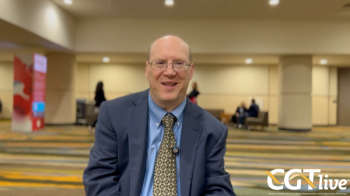
AAV Immuno-Gene Therapy May Hold Untapped Potential in Oncology Indications
Nicole Paulk, PhD, the CEO, founder, and president of Siren Biotechnology, discussed research she presented at ASGCT’s 2023 conference.
Adeno-associated virus (AAV) vector-based gene therapies are primarily associated with the treatment of monogenic rare inherited diseases via the provision of functional copies of the disease-targeted gene. Indeed, most FDA-approved AAV vector-based gene therapies and many AAV vector-based gene therapies currently being evaluated in clinical trials fit into this category. That said, some companies and organizations are currently evaluating other applications of AAV vector-based approaches.
At
In an interview with CGTLive™ at the conference, Paulk discussed the data she presented and their implications. She emphasized the potential of the approach to treat additional cancer types beyond high grade glioma and also spoke to the challenges of mouse model research in the immuno-oncology space.
CGTLive: Can you give some background information on the question or problem that your research was trying to address?
Nicole Paulk, PhD: We were really interested in trying to set up the world's first universal AAV gene therapy. To date here at the ASGCT meeting, most folks are doing AAV gene therapies for rare monogenic diseases—so they can only be used to treat a single indication. We wanted to make an AAV gene therapy that can be used to treat multiple indications—you know, 2, 20, [or even] 200—and really got excited about actually applying this in the oncology space rather than the rare monogenic disease space. We showed the last 7 years’ worth of data from my lab and now at the company about testing the first from our platform of these universal AAV immuno-gene therapies in the high-grade glioma space. That was the main portion of data that we showed at the meeting, but we have additional indications that we're interested in going after next.
Can you give an overview of the key results you presented?
We went from the beginning of the project all the way up to now; it's about 7 years’ worth of data since we've never presented this before. We basically made a library of AAVs that express a bunch of different engineered cytokines and we wanted a setting where we could test these in high throughput. First, we established a bunch of organoid data with a bunch of primary human brain organoids. From these primary human brain organoids, we can basically have mini healthy brains and then we can spike in primary tumor samples taken directly from patients that will allow us to both interrogate whether or not we can see tumor killing in the tumor cells, but also whether or not we see sparing of the healthy cells. This allows us to do it in high throughput, unlike what's possible in the in vivo setting with animals; so, we could test dozens and dozens and dozens of AAVs in these primary cerebral brain tumor organoids first to identify which cytokine payloads were working the best with antineoplastic and immunomodulatory effects within the organoids and then advance those candidates into in vivo studies.
Then we showed all of our data from both cell-line derived xenograft mice and patient-derived xenograft mice, as well as syngeneic allograft mice, with our lead AAV immuno-gene therapy. We treated about 450 mice, and we showed all of the improvements in complete responses, overall survival, and long-term durability, dose escalations, and dose deescalation data—as well as some new data where we were taking an ex vivo approach and taking a number of additional whole fragment tumor samples from a variety of other solid tumors in order to determine whether or not we could treat additional cancers beyond the glioma space. We were testing both primary as well as metastatic cancers in an ex vivo setting in high throughput, where you can basically maintain the tumors as fragments that still have tumor cells and healthy cells and immune infiltrating cells—so kind of that whole environment—and then testing those in high throughput, ex vivo, with a number of our AAV gene therapies and looking to see: how broadly could this go, how many additional cancers could we potentially treat? And we saw a lot of really positive data. That data was still anonymized—we didn't disclose what the indications were—but showed the promise of the platform.
What are the main implications that the healthcare community should take away from these findings?
I think this is a really exciting time. This will be the first ever AAV in the oncology space so we'll have a whole new modality to add to the arsenal of things that we can go after cancer with. Especially when we're talking about the brain cancer space in particular, it's a very challenging environment and a very challenging organ because there just hasn't been a lot of successes regardless of modality: small molecules, cell therapies, antibody drug conjugates, monoclonal antibodies, etc. Having a whole new modality class to come at these particular cancers, I think is going to be, hopefully—fingers crossed—a transformative moment so we can get more options for patients.
Were there any challenges or limitations in your research?
I would say the biggest challenge whenever you're working with an immunotherapy in mice is that your drug product is human, so you need to use that in a xenograft setting, but in order to get those human tumor samples to engraft you have to do it in an immunodeficient mouse; typically, an athymic mouse or even more immunodeficient mouse. So, you kind of have to have 2 drug products: you have the human version that you test in your xenograft setting and then you have the mouse version that you test in in the syngeneic allograft setting so that always just makes it challenging. That's a problem all of us in the immuno-oncology space experience so that just adds to development times and expense and these types of things, but so far, the data has all tracked and so we've been really excited.
Is there anything else you’d like to share with the audience?
The biggest thing of the week was that we finally came out of stealth. This is something we've been working on in my lab in academia for the last 5 to 7 years and the last 2 years in the company and so it was just a really special treat to be able to come out of stealth at the biggest gene therapy meeting in the world amongst all of our friends. It's been a really fun week.
Transcript edited for clarity.
REFERENCE
Clement N, Morris S, Kuwahara A, et al. AAV immuno-gene therapy delivers vectorized cytokines to effectively treat high grade gliomas. Presented at: American Society of Gene and Cell Therapy (ASGCT) 2023 Annual Meeting. May 16-20, 2023; Los Angeles, CA. Abstract #60.
Newsletter
Stay at the forefront of cutting-edge science with CGT—your direct line to expert insights, breakthrough data, and real-time coverage of the latest advancements in cell and gene therapy.











































